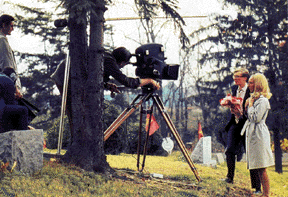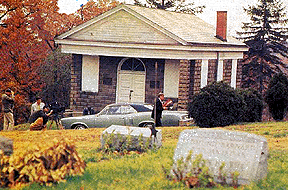night OF THE
LIVING DEAD PRODUCTION
 Back row: Tony Pantanello, Keith Wayne, Karl Hardman, Marilyn
Eastman, Duane Jones, Judy Ridley, Judy O'Dea. Second row: Regis Survinski,
Betty Ellen Haughey, Russ and Gary Streiner, John Russo; Mary Russo and George
Romero.
Back row: Tony Pantanello, Keith Wayne, Karl Hardman, Marilyn
Eastman, Duane Jones, Judy Ridley, Judy O'Dea. Second row: Regis Survinski,
Betty Ellen Haughey, Russ and Gary Streiner, John Russo; Mary Russo and George
Romero.
Contributing $600 of their own money each,
Image Ten was formed of the ten investors from Latent Image and Hardman-Eastman:
George Romero (president, director/cinematographer), Russel Streiner (vice
president, producer), John Russo (secretary, writer, assistant cameraman), Vince
Survinski (treasurer, production manager/designer), Gary Streiner
(recording/mixing), Richard Ricci (actor), Rudy Ricci (actor), Karl Hardman
(co-producer, sound, makeup, still photography), Marilyn Eastman (actress,
sound, makeup, production assistant). Dave Clipper (attorney). Realizing they’d
need much more than six grand, each person brought in another investor and soon
they had $14,000 which went to pre-production costs (including script, casting,
location, makeup and production design). Another $20,000 went to actors, another
$20,000 to artwork and ads. The lab bills themselves cost $60,000.
It was Betty Ellen Haughey who suggested Duane Jones audition for the role of
the truck driver Ben. Jones was a graduate of the Actors Studio in New York and
had three years worth of off Broadway experience. Critics tried to read into the
purpose of casting a black man in the lead as a racial statement. More than once
Romero has explained this; the final word had to be in Russo’s Complete
Night of the Living Dead Filmbook: "We cast a black man not because he
was black but because we liked Duane’s audition better than the others we had
seen. The sociopolitical implications of Ben’s being black have been studied
and pondered and written about in various journals and it caused one critic in
his exuberance to write that he heard the strains of "Ole Man River"
in the music score when Ben meets his fate."
Judy O’Dea flew home to Pittsburgh to audition for Barbara. She had been in
Hollywood looking to be an actress. When it was decided to include a couple in
the script, Latent Image receptionist Judith Ridley had already lost her role to
O’Dea. Ridley told Marilyn Eastman in the 1993 Elite laserdisc interview,
"I was dreadful when I read for Barbara. I was out of my league – I had
never done any acting. They took pity on me. They wanted to find a little spot
for me. But I was not prepared to be Barbara." Her boyfriend in the film,
Keith Wayne Hartman was the only one paid actor, receiving $1500 for his role.
Though a graduate of the Pittsburgh Playhouse School of Theater, acting was a
second love with Hartman, as he preferred singing in nightclubs. Romero wrote in
the "smile for me" scene at 5 in the morning to make the audience
sympathetic just before their fiery deaths.


To create the illusion of a still lived-in home,
it was decorated with $50 worth of Goodwill furniture, picked up by Vince
Survinski and driven to the location in a U-Haul truck. His sister contributed
the musicbox (stolen during the last day of shooting). The melody had to be
recorded from Hardman’s mother’s musicbox. Survinski built a fireplace
(demanded in the script to light fires) by removing a wall, as well as a fake
cellar door.
George Kosana, who acted as the police chief in
the film, brought in his personal trophy animal heads as well as the Winchester
lever-action rifle. He was also firearm supervisor. He was considered a ‘natural’
actor considering he had no dramatic training; he even improvised the famous
line "they’re dead…they’re all messed up."
George, Gary, Vince and John all lived at the
house, sleeping on cots from an army surplus store. When they bathed, water from
the spring was boiled on a hot plate. Russo volunteered to play one of the
ghouls at night so the rest of the cast and crew could go home.
The effects were mostly done by Karl Hardman and
Marilyn Eastman. Romero bought and converted twenty five used mannequins with
clay–sculpted damage. They were created for severe zombie violence and bonfire
scenes. These were left in the windows of the house and sometimes teenagers
would break into the house and further ‘abuse’ the dummies. The skull of the
lady upstairs was a plastic skull kit that Romero made to look as if partially
eaten. "The eyes were ping pong balls!" he laughs. Kyra Schon doubled
for the body of the lady that Ben moves out from the top of the stairwell.
The intestines were not effects; Ross Harris ran a butcher shop and brought
those in. Real blood was not used on the other hand. The crew found Bosco
chocolate syrup registered on black and white film just as nasty as stage blood
would. In the scene where Karen stabs her mother, black paint was splashed on
the wall.
As an afterthought, John Russo suggested taking
the cameras to Washington D.C. to shoot some capital footage that would imply
national emergency. This led to the scripting of some clever dialogue by the
military generals on what is causing the molecular mutations believed to be the
root of the crisis. The crew debated the idea whether the phenomenon needed an
explanation at all. Russo played the general’s driver, wearing his old Army
uniform and Marilyn created the red flags for the general’s car.
Karl’s idea for an ending was described in Cinefantastique:
"I wanted to have everything wrapped up. Duane shot. All the ghouls wiped
out. And then I wanted to have the little girl step up into the frame as the
posse drives away in the distance, watching the posse disappear. To have one
ghoul left."
Another problem arose with music. To avoid the
trouble of creating an original score, two alternatives were considered. The
first was purchasing the rights to Jack the Ripper’s score. The other
option was using needle-drop music (canned tracks). Romero explained best on the
soundtrack record that was belatedly released in 1982. "Frustrating for us all was that none among us could write or play music,
not that our budget would have allowed for a recording session, but I'm sure we
would have tried had any of us the talents to make the try worthwhile. So, Karl
Hardman and the Capitol Hi-Q Library to the rescue. Karl's production company
had the library discs in house and he began to make preliminary picks. We
listened and were delighted with the music. This was the real article. The
scoring heard in nightmares conjured by yesterday's matinees. If the boogie man
had a ghetto blaster, this is the stuff he'd boogie to. Karl gets the credit for
picking the takes and I got the fun of gluing them together onto the film."
 Back row: Tony Pantanello, Keith Wayne, Karl Hardman, Marilyn
Eastman, Duane Jones, Judy Ridley, Judy O'Dea. Second row: Regis Survinski,
Betty Ellen Haughey, Russ and Gary Streiner, John Russo; Mary Russo and George
Romero.
Back row: Tony Pantanello, Keith Wayne, Karl Hardman, Marilyn
Eastman, Duane Jones, Judy Ridley, Judy O'Dea. Second row: Regis Survinski,
Betty Ellen Haughey, Russ and Gary Streiner, John Russo; Mary Russo and George
Romero.
